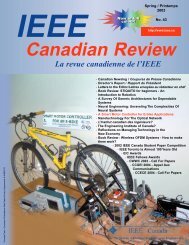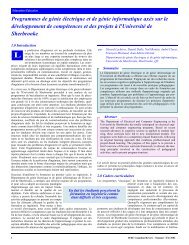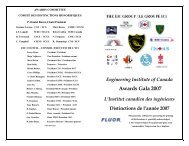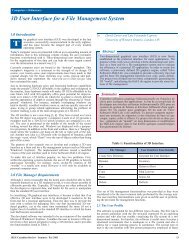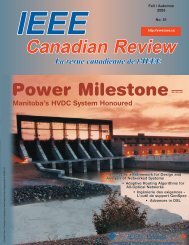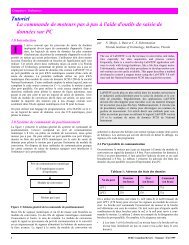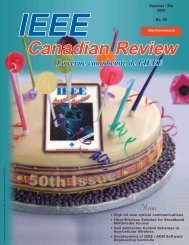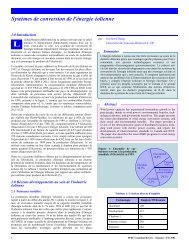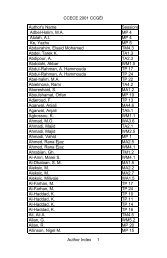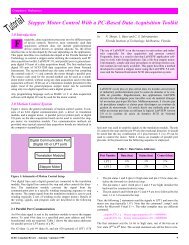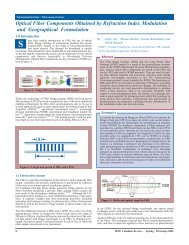Click Here - IEEE
Click Here - IEEE
Click Here - IEEE
- No tags were found...
Create successful ePaper yourself
Turn your PDF publications into a flip-book with our unique Google optimized e-Paper software.
Thursday August 26, 2010TM1TM2TM3TM4TP1TP2TP3TP4TE1TE2TE3TE4Control Aspects IEnergy ManagementIntelligent SystemsPower System DynamicsControl Aspects IIEnergy Storage SystemsOperational SchedulingRenewable EnergyDesign AspectsHVDCPower ElectronicsSmart Grid
Acadia A (1) 10:20-10:44 Acadia A (2) 10:44-11:08Acadia A (3) 11:08-11:32 Acadia A (4) 11:32-11:56Acadia A (5) 11:56-12:20TM1:Control Aspects ISession Chair: Dr. Jason Gu and Dr. Hao ChenAcadia A 10:20-12:20 Thursday, August 26Design of Bilateral Switched ReluctanceLinear GeneratorH. Chen1,3, X. Wang1, J. J. Gu2, S. Lu11China University of Mining & Technology, Xuzhou 221116, China, hchen@cumt.edu.cn2Dalhousie University, Halifax, NS, Canada B3J 2X4, jason.gu@dal.ca3The University of Western Australia, 35 Stirling Highway, Crawley, WA 6009 Australia• The paper presented the designobjective of three-phase 6/4structure long-mover bilateralSwitched Reluctance lineargenerator.• The structure, the main designparameters are described.• The design procedure andexample of a developedprototype with rated outputpower 200 W, rated velocity 2m/s, and output voltage forwindings 24V are given.Main structure dimensions diagram oflong-mover bilateral Switched Reluctancelinear generatorA new Closed Loop Speed Control of InductionMotor Fed by A High Performance Z-SourceInverterOmar Ellabban, Joeri Van Mierlo and Philippe LataireDepartment of Electrical Engineering and Energy TechnologyVrije Universiteit Brussel• The speed control is based on both:V/F and indirect field-orientedcontrol strategies.• The indirect field-oriented controlbased on PWM voltage modulationwith voltage decouplingcompensation• A dual loop controller is designedto control the peak dc link voltageof the ZSIClosed loop speed control of three phaseinduction motor fed by high Performance ZSIWide-Area Frequency Control during PowerSystem RestorationVahid Yari, Saber Nourizadeh, Ali Mohammad RanjbarDepartment of Electrical EngineeringSharif University of TechnologyTehran, Iran• A new method for frequency control ispresented which determines themaximum load pickup within theallowable frequency ranges for stage ofload restoration.• A single-machine equivalent for eachpower system island is computed onlineusing PMUs. Using this model theprogression of frequency stability aftera disturbance is predicted, so suitableamount of load pickup or generationincrease can be determined for thesupervised island of the power system.New England 39 bus system afterislandingSimulation on Parallel Drive System ofDouble Switched Reluctance Motors Basedon Sliding Mode & Fuzzy ControllersH. Chen1,3, X. Wang1, J. J. Gu2, Q. Song11China University of Mining & Technology, Xuzhou 221116, China, hchen@cumt.edu.cn2Dalhousie University, Halifax, NS, Canada B3J 2X4, jason.gu@dal.ca3The University of Western Australia, 35 Stirling Highway, Crawley, WA 6009 Australia• The sliding mode controlalgorithm is adopted in the maincontroller for closed-loop rotorspeed control of main motor. Thefuzzy control algorithm isadopted in the subordinatecontroller for synchronized rotorspeed and loads equilibriumdistribution between main motor Block Diagram of Parallel Drive Systemand subordinate motor.Control of a Bidirectional Z-Source Inverter for HybridElectric Vehicles in Motoring, Regenerative Brakingand Grid Interface OperationsOmar Ellabban, Joeri Van Mierlo and Philippe LataireDepartment of Electrical Engineering and Energy TechnologyVrije Universiteit Brussel• This paper presents a battery suppliedbidirectional Z-Source Inverter (ZSI)fed a three phase induction motor• The indirect field-oriented controlbased on PWM voltage modulationwith voltage decoupling compensation• In addition, this paper presents thegird interface mode with its control tocharge or discharge the battery fromthe grid.Closed loop speed control of three phase inductionmotor fed by a bidirectional ZSIControl strategy of grid connected bidirectional ZSIO-3
TM2:Energy ManagementSession Chair: Dr. Voicu Groza and Dr. Walid MorsiAcadia B 10:20-12:20 Thursday, August 26Acadia B (1) 10:20-10:44 Acadia B (2) 10:44-11:08Energy Harvesting Simulation for AutomaticArctic Monitoring StationsD. Pimentel, P. Musilek, and A. KnightElectrical and Computer Engineering, University of AlbertaEdmonton, Alberta, Canada T6G 2V4• A multisource energy harvestingsimulator is presented.• Real climatological data is used asan input for the simulator.• Simulation results show the needfor advanced power management.• Future research: sizing of the powersource for different Arctic locations,development and optimization of afuzzy power managementalgorithm, and case studies.PowerconditioningPowerconditioningBatteryAutomatic monitoringstation energy flowSensors andsatellitetransmissionAcadia B (3) 11:08-11:32 Acadia B (4) 11:32-11:56DataloggerUsing Global Efficiency Concept inSelection Decisions of Dedicated EquipmentsConstantin. D. Pitis 1 Voicu Z. Groza 21 # 900 - 4555 Kingsway, Burnaby, BC,V5H4T8, Canada2 800 King Edward Ave., Ottawa, ON, K1N 6N5, Canada• The paper presents essentials ofconverter types (single andcomplex) and basics of the GlobalEfficiency (GEff) concept that hasbeen promoted over the last fewyears in South African industries.• Theoretical and technical aspects ofGeff were substantiated with casestudies.• A case study of a single stage axialfan is presented.Schematic power flow diagramenables study of the power losses byusing dedicated mathematical modelModeling and Simulation of a Soft-Starterfor a 2 MW Wind Turbine GeneratorsL. Mihet-Popa*and V. Groza**, senior member <strong>IEEE</strong>* POLITEHNICA University/Electrical Machines and Drives, Timisoara, Romania;** University of Ottawa/Dept. of Information Technology and Engineering, Canada• A soft-starter model and its controlstrategy for connecting solutions tothe grid of different operationmodes for a wind turbine generatorof 2/0.5 MW were evaluated;• The thyristors switching fordifferent functions of the firingangle has been discussed;• A complete simulation model of aconstant speed wind turbine withcage rotor and double statorwindings induction generator hasalso been presented.Simplified scheme of the wind turbine modelA Demand Side Management Program usingWater Heaters and Particle Swarm OptimizationArnaldo Sepulveda, Liam Paull, Walid G. Morsi, Howard Li, C. P. Diduch and Liuchen ChangDepartment of Electrical and Computer Engineering, University of New BrunswickFredericton, New Brunswick, Canada• Proposed method schedule waterheaters operation using particleswarm optimization (PSO).• Proposed method reduced theaggregated household peak loaddemand and filled valleys.• Temperature of water heaters areaccounted in the optimizationalgorithm to ensure customersatisfaction.Aggregated load demand responsesimulation using PSO to control waterheatersAcadia B (5) 11:56-12:20A Centralized Genetic Algorithm Controller to Control PowerDemands of Electric Water Heaters for Peak Shaving ofResidential ConsumersM. Shaad, W. G. Morsi, C. P. Diduch, H. Li, L. ChangSustainable Power Research Group, University of New BrunswickFredericton, New Brunswick, Canada• A centralized controller is proposedto control load demand of domesticelectric water heaters (DEWH).• This controller finds the bestpatterns of working for eachindividual DEWH to shave the peakof load demands.• Simulation results show that thisComparison between total powermethod can reduce the peak ofdemands of 500 households with GAdemands up to 3%controller and without controllerO-4
l ambda= 4.40O PFMW generation = 72.39 MWcost/hr = 505.96 $/hrprofit/hr= -187.44 $/ hMW load = 69.00 MW14%AMVAA8%MVA9A45 MW39%9%AMVA8MVA76 MvarA622%MVAA23 MW52%MVA11 MvarA755%MVAA15%10.0 MvarMVA5A47%MVA50 MW47 Mvar282411%AA34%MVAMVA-5 Mvar77 MW 8 MW2 Mvar94 MW 22 MW19 Mvar 13 MvarA37%MVAA74%MVA172 MWsl ack-10 MvarA18%MVAA57%MVAA37%MVAA8%MVA314%AMVA8 Mva r11 MW2 MW1 Mv a r1130 MW12 Mvar21%AMVA1%A10AMVA10%MVA7%AMVA6 MW2 Mvar1713 6 Mvar9 MWA40 MW 4%45%A 23 MvarMVAMVAA7%MVA16A13%MVA4 MW1 Mvar12A10%MVA14A6 MW27%2 Mva rMVA4%AMVA15A16%MVA8 MW3 MvarA5%MVAA6%MVA2729A4%MVA2 MW1 Mva r 3011 MW2 Mv a rA7%MVA183 MW1 Mv a rA6%MVA25214 MW2 Mvar18 MW11 Mvar2220A2 MW 10%MVA1 Mva r9 MW24A5%7 MvarMVAA2%MVA3 MW 2319 2 Mvar10 MW3 Mvar4%AMVA263%AMVAO PFlambda= 6.84pr ofit = - 1039.00 $/hMW generation = 232.26 MWMW l oad = 229.40 MWcost/hr = 2627.68 $/ hrTM3:Intelligent SystemsSession Chair: Dr. Wahab Almuhtadi and Dr. Juan Alvarez LopezAcadia C 10:20-12:20 Thursday, August 26Acadia C (1) 10:20-10:44 Acadia C (2) 10:44-11:08Neuro-Wavelet Based IslandingDetection TechniqueYara Fayyad and Ahmed OsmanDepartment of Electrical Engineering, American University of SharjahSharjah, UAE• Neuro-wavelet based islandingGdetection technique has beendeveloped.• The method is based on the analysisof the transient voltage signalsgenerated during the islanding event.• The performance of the proposedtechnique is compared withconventional islanding detectiontechnique and it gives superior results.Line 1CB1LoadLine 2PCCDG1CB2TxDG2L CB3oTxadSystem modelPassive Method-Based Islanding Detection of Renewable-BasedDistributed Generation: The IssuesbyA.S. Aljankawey, Walid G. Morsi, L. Chang and C. P. DiduchUniversity Of New Brunswick, Fredericton, NB, Canada• An island is when a a portion of the system becomes isolated from thegrid and the DG(s) in the isolated portion continues to power the localloads.• Active methods inject distortion to the grid and degrade the powerquality.• Communication-based detection methods are very expensive.• Passive methods are inexpensive, cost-effective especially for RDGswhile they rely only on local measurements.• Future research should address power quality levels when using passivemethods.Acadia C (3) 11:08-11:32 Acadia C (4) 11:32-11:56Practical Commitment of Combined Cycle Plantsusing Dynamic ProgrammingJuan Alvarez Lopez, Rolando Nieva Gomez, and Isaias Guillen MoyaElectric Research Institute of Mexico, Cuernavaca, Morelos, Mexico• More accurate model based onconfigurations.• New configurations modeled likestart-up sequences and different stopmodes.• Simplification of the state-spacediagrams by using a single integerstate index that represents thestate/configuration of the CCP.• Modeling of a Hybrid CCP(auxiliary boiler).Schematics of a CCP with AuxiliaryBoilerOPTIMAL POWER FLOW USING POWERWORLD SIMULATORHarprit kaur (student) and Y.S Brar(Professor)Electrical Engineering department, Guru Nanak Dev Engineering College, Ludhiana,Punjab, IndiaJaswinder Singh Randhawa (Lecturer)Department of Computer application, Chandigarh Engineering College, Mohali,Punjab, India•The formulation of theOptimal Power Flowproblem in detail.• Power world Simulator isused for solving <strong>IEEE</strong>-30bus system.•<strong>IEEE</strong> 30 bus systemoneline diagram consideredfor OPF.130 Mvar 35 MW2Acadia C (5) 11:56-12:20Protection Challenges facing DistributedGeneration on Rural FeedersAidan Foss and Kalle LeppikANF Energy Solutions, Ottawa, Canada• Experience with connecting farm biogas generation to rural distribution feedersin Ontario has revealed several challenges with electrical protection. The biogasprojects are small (
Session Chair: Dr. Branislav Djokic and Dr. Melike Erol-KantarciTupper Room 16:20-18:20 Thursday, August 26Tupper Room (1) 16:20-16:44 Tupper Room (2) 16:44-17:08The Impact of Smart Grid Residential Energy Management Schemes ontheCarbon Footprint of the Household Electricity ConsumptionMelike Erol-Kantarci and Hussein T. MouftahSchool of Information Technology and EngineeringUniversity of Ottawa• The time of consumption affects the carbon footprint of theconsumers• In peak hours, utilities bring peaker plants online which usemore expensive resources such as coal, natural gas, etc• These resources have higher GreenHouse Gas (GHG) emissions• In this paper, we investigate the impact of the residential energymanagement schemes on the carbon footprint of an householddue to electricity consumption• We show that energy management schemes decrease the peakhour usage of the appliances which consequently, decreases thecarbon footprint of the consumersTE4:Smart GridVoltage Collapse Detection Using Ant ColonyOptimization for Smart Grid ApplicationsC. Church, Walid G. Morsi, Member <strong>IEEE</strong>, C. P. Diduch, Member <strong>IEEE</strong>, M. E. El-Hawary,Fellow <strong>IEEE</strong>, and L. Chang, Senior <strong>IEEE</strong>• In this study Ant ColonyOptimization is applied to detectvoltage collapse conditions in powernetworks, to obtain faster computingtime with the future goal ofproviding online detection andprediction for use in smart grids.• Results and conclusions drawn fromthis study are also presented.Global fitness function resultsTupper Room (3) 17:08-17:32 Tupper Room (4) 17:32-17:56Design of a Smart Meter Techno-EconomicModel for Electric Utilities in OntarioElise Andrey and Jordan MorelliDepartment of Physics, Engineering Physics & Astronomy, Queen’s UniversityKingston, Ontario, Canada• A techno-economic model comparing various functionalitylevels of Smart Meters has been designed.• Three levels of functionality were considered.– Minimum functionality smart meters,– Smart meters with in-home displays, and– Smart meters with a demand control unit.• The functionality levels were compared based on the annualprofit obtained and the overall reduction in energy consumption.• Based on a number of case studies, minimum functionalitysmart meters were found to be the most profitable; however,smart meters with a demand control unit provided the greatestreduction in energy usage during peak demand times.Vehicle to Grid in Nova ScotiaKaren Pahlavan and Tim LittleDepartment of Electrical and Computer EngineeringDalhousie University, Halifax, Nova Scotia, Canada• Nova Scotia has high per capita emissionsand needs a strategy like V2G in order toreduce its environmental footprint.• V2G can be used to reduce emissions inboth the power generation andtransportation sectors.• V2G also provides the energy storage andspinning reserve capacity needed tofacilitate wind energy systems.• V2G is shown to be beneficial to theprovince as its dependence on fossil fuels isreduced.V2G ConceptO-14
Friday August 27, 2010FP1Wind Power IFP2System Dynamics IFP3FP4Storage TechnologySystem DesignFE1Wind Power IIFE2System Dynamics IIFE3Alternative EnergyFE4Intelligent Systems
FP2:System Dynamics ISession Chair: Dr. Wahab Almuhtadi and Dr. Walid G. MorsiAcadia B 14:00-16:00 Friday, August 27Acadia B (1) 14:00-14:24 Acadia B (2) 14:24-14:48A Novel Efficient PSO-Self Regulating PID A Novel GA-SelfRegulating VSC-SMC Controller for Common AC-DC PV-FC-Diesel-Battery Green Energy Utilization SchemeAdel M. Sharaf and Adel A. A. El-GammalCentre for Energy Systems, University of Trinidad and Tobago UTTA Novel Efficient PSO-Self Regulating PID Controllerfor Hybrid PV-FC-Diesel-Battery Micro Grid Scheme forVillage/Resort Electricity UtilizationAdel M. Sharaf and Adel A. A. El-GammalCentre for Energy Systems, University of Trinidad and Tobago UTTA novel application of Multi ObjectiveGenetic search Algorithms MOGA tooptimally tune the gains of the variablestructure sliding mode dynamiccontroller (VSC-SM) to control the 6-pulse controlled rectifier converter,dynamic filter/capacitor compensationDFC and the Green Power Filter GPFAC and DC schemes using real timedynamic self regulating error tracking.DC bus voltage plot obtained with GAbased tuned variable structure slidingmode dynamic controller.The paper presents a novel applicationof Multi Objective Particle SwarmOptimization MOPSO for PIDcontroller parameters tuning to controlthe 6-pulse controlled rectifierconverter, dynamic filter/capacitorcompensation DFC and the GreenPower Filter GPF AC and DC schemesusing real time dynamic self regulatingerror tracking.Tri-loop error driven self tuned variablestructure sliding mode dynamic controllerthe AC side DFC filter compensatorschemeAcadia B (3) 14:48-15:12 Acadia B (4) 15:12-15:36Optimal PID-Self Regulating Controller forMicro Hydro-Fuel Cell GreenEnergy Management SchemeAdel M. Sharaf and Adel A. A. El-GammalCentre for Energy Systems, University of Trinidad and Tobago UTTThis paper presents a novel ElectricEnergy Management compensator basedon Multi Objective Particle SwarmOptimization search technique OPSO foruse in hydrogen and island electricitygeneration. It combines a fuel cell powersource and a micro hydro water turbine.The novel control strategy is designed toachieve the high-efficiency coordinatedoperation of the two individual powersources and to regulate current andvoltage for maximum utilization, withoutcompromising the power quality andperformance of the overall system.Simplified diagram of thePEMF-C systemOptimal Selection of Capacitors in DistributionNetworks for Voltage Stabilization and Loss ReductionAdel M. Sharaf and Adel A. A. El-GammalCentre for Energy Systems, University of Trinidad and Tobago UTT• A novel discrete optimization approachto optimally solve the sizing problemof capacitor for the voltage stabilityenhancement in radial distributionnetworks using Discrete MultiObjective Particle Swarm OptimizationMOPSO technique.• The novel optimization approach usingMOPSO is implemented to tackle anumber of conflicting goals that definethe complex optimality problem.Flow chart of the MOPSO optimizationsearch algorithmO-16
Session Chair: Dr. Sheldon Williamson and Dr. Hao ChenTupper Room (1) 14:00-14:24 Tupper Room (2) 14:24-14:48Tupper Room (3) 14:48-15:12 Tupper Room (4) 15:12-15:36Tupper Room (5) 15:36-16:00FP4:System DesignTupper Room 14:00-16:00 Friday, August 27Lightning Risk Assessment of PowerSystemsRiadh W. Y. Habash and Voicu GrozaSchool of Information Technology and Engineering, University of Ottawa, Ottawa,Ontario, Canada• This work focus on developingmaterials on lightning risk analysisaimed at teaching power systems.• It describes series of case studiesinvolving lightning effects onsubstations, transmission lines,and wind turbine systems.• Case studies use varioussimulation tools such as Simulink,CADFEKO, and LABView.Metering of Energy Used for Lighting:a Practical Indirect MethodLuigi Martirano*, Massimo Aliberti#, Ferdinando Massarella+*Electrical Engineering Department University of Roma “La Sapienza”#Istituto di Scienza e Tecnologie dell’Informazione “A. Faedo” Consiglio Nazionale delle Ricerche+ Massaerella Engineering ing.massarella@gmail.com• A simple method was proposed formetering of energy used forlighting.• The method adopts ordinaryactuators and a basic supervisorysystem with a low cost impact.• Smart metering exploits thecapacity of BACS to quantifyenergy consumption and provideappropriate information toSynthesized Grips on Different Objectsconsumers.A Sectionalizing Method in Power SystemRestoration Based on Wide Area MeasurementSystemsS. A. Nezam-Sarmadi, A. Salehi, S. Azizi, A. M. Ranjbar and S. Nouri-ZadehDepartment of Electrical Engineering, Sharif University of TechnologyTehran, IranDistribution System Efficiency Improvement byReconfiguration and Capacitor Placement Using aModified Particle Swarm Optimization AlgorithmPooya Rezaei and Mehdi VakilianElectrical Engineering Department, Sharif University of TechnologyTehran, Iran• Capacitor Placement/setting and Reconfiguration are used tominimize two objective functions including total costs and totallosses.• PSO is utilized to solve the above combinatorial non-linearproblems because of its robustness and searching efficiency in thesearch space.• Reconfiguration is also considered as a means for modifying thebase network structure in capacitor placement problem.• Two targets are achieved including energy efficiency and costeffectivecapacitor investment.Modeling of Optimal Electricity Supply Problemin Iran’s Power Network by Using HierarchicalPlanning ApproachR. Tanha Aminloei and S. F. Ghaderi, Jr.Department of Industrial Engineering, University of Tehran, Iran• A modeling by selecting a Fuzzy Hierarchical ProductionPlanning (FHPP) technique with zone covering in the mid-termand long-term time horizons electricity supply modeling in theIran global compact network with spotting 15 zone electricitystudy is proposed.• Capacity, Max development, Max energy product of eachproduction unit, reliability and autonomy constraints areconsidered.• Other objective functions include parameters that minimizeproduction, development and security costs of the systemconsidering capital recovery factor, interest rate that maximizetotal preference weights of power plants.• A Sectionalizing method wasproposed to build-up a power systemfor restoration purpose.• The proposed method made theNew-England 39 bus system to fourislands that could be restoredsimultaneously.Sectionalized Network of New-England39 bus system.O-18
FE1:Wind Power IISession Chair: Joy Brake and Dr. Adel MerabetAcadia A 16:20-18:20 Friday, August 27Acadia A (1) 16:20-16:44 Acadia A (2) 16:44-17:08Techno-Economic Assessment ofIntegrating Wind Farms into PowerGeneration SystemMohamed A. H. El-SayedUtilities Engineering EgyptianUniversity of Trinidad and TobagoEffat A. MoussElectricity Holding CoNasr City, Egypt• A hybrid reliability approach was proposed based ondeterministic and probabilistic system characteristics to definethe capacity credit of WECS taking into consideration the effectof the system dynamic behavior due to either of sudden loss oflarge generating units or loads.• An economic technique to evaluate the feasibility of integratingWECS was presented to select their optimal size taking intoaccount the environmental concerns.• Sensitivity cost analysis is carried out to validate the feasibilityof implementing WECS.Predictive Tracking Controller for InductionGenerator in Variable Speed Wind EnergyConversion SystemsAdel Merabet 1 and Jogendra S. Thongam 21 Division of Engineering, Saint Mary’s University, Halifax, Nova Scotia, Canada2 Department of Renewable Energy Systems, STAS Inc., Chicoutimi, Quebec, Canada• In this paper, the problem of trackingcontrol for variable speed windinduction generator (IG) energyconversion system (WECS) isinvestigated using nonlinear predictivecontrol.• A rotor speed predictive controlalgorithm has been designed to controlthe angular speed of the machine inorder to allow the WECS operate withmaximum power extraction.Acadia A (3) 17:08-17:32 Acadia A (4) 17:32-17:56Dynamic Modeling and Simulation of a RemoteWind-Diesel-Hydrogen Hybrid Power SystemMd. Maruf-ul-Karim and M. T. IqbalFaculty of Engineering and Applied Science, Memorial University of NewfoundlandSt. John’s, Newfoundland, Canada Dynamic model of Wind-Diesel-Hydrogen based Ramea power systemhas been developed. Hydrogen as a storage medium is anovel approach adopted in this system. Introducing of new WECS is aiming atincreasing the penetration level. The dump load used in this systemplayed an important role in maintainingstability.The Infrastructure of Ramea PowerSystemGenerator speed tracking withreal wind speed profileWind Power Forecastingbased on Econometrics TheoryHui Zhou and Jiangxiao FangSchool of Electrical Engineering, Beijng Jiaotong UniversityBeijing, China• ARCH effect exists in the fluctuated windspeed sequences.• Based on econometrics theory, ARCHmodel and GARCH model of wind speedare established, both models have betterforecasting precision than ARIMA.• Plenty of numerical calculationdemonstrates that GARCH model has betterapplicability.• Based on wind power curve of a typicalwind turbine , forecasted wind power ofnext day is gotten.A Dynamic Consequence of Wind speedPower Curve of a Typical Wind TurbineAcadia A (5) 17:56-18:20Direct Torque and Flux Control of the Converters for aPermanent Magnet Wind Power Generation SystemZ. Xu, P. Ge, Dianguo Xu and C.H.ZhangHarbin Institute of Technology, 150001Harbin, China• This paper presents a Space-VectorModulated (SVM) Direct-Torque-Control (DTC) scheme for a directdrivepermanent magnetsynchronous generator (PMSG) anda gird converter for wind energywithout any position sensor.• SVM-DTC can also be implementedinto the grid converter in whichnearly sinusoidal input current andThe overall structure of the adaptive observerfast dc link voltage regulation canbe achieved.O-19
FE2:System Dynamics IISession Chair: Dr. Jason Gu and Dr. Sheldon WilliamsonAcadia B 16:20-18:20 Friday, August 27Acadia B (1) 16:20-16:44 Acadia B (2) 16:44-17:08A Novel GA-Based Tri Loop Multi-StageIncremental Action Drive Controller for HybridPV-FC-Diesel-Battery Electric VehicleAdel M. Sharaf, Senior Member <strong>IEEE</strong> and Adel A. A. El-Gammal, <strong>IEEE</strong> MemberCentre for Energy Studies, University of Trinidad and Tobago UTT• A novel self regulating tri loop self tunedmulti-Stage incremental action controller fora hybrid PV-FC-Diesel-Battery powered allwheeldrive electric vehicle using fourPermanent Magnet DC (PMDC) motors ispresented.• A Tri Loop dynamic error driven scheme isproposed to regulate motor current againsthigh inrush currents and motor overloadingconditions.• The integrated scheme is fully stabilizedusing a novel FACTS based green filtercompensators.EV-PMDC Motor Speed response for the thirdspeed track using GA based tuned Tri-loop Multi-Stage Incremental Action ControllerA Novel PSO-Based Hybrid PV-FC-Diesel-BatteryElectric PID-Controller Drive System for ElectricVehicle TractionAdel M. Sharaf and Adel A. A. ElgammalCentre for Energy Studies, University of Trinidad and Tobago UTT• A novel PID self regulating tri loopcontroller for a hybrid PV-FC-Diesel-Battery powered all-wheeldrive electric vehicle using fourPermanent Magnet DC (PMDC)motors, which are modeled toinclude existing nonlinearities inmotor plus load inertia (J) andviscous friction (B).Schematic diagram of a prototype all-wheeldrive electric vehicle using four PMDCmotorsAcadia B (3) 17:08-17:32 Acadia B (4) 17:32-17:56Novel Green Plug Switched Filter SchemesBased On Multi Objective Genetic AlgorithmMOGA for Single Phase Induction MotorsAdel M. Sharaf and Adel A. A. ElgammalCentre for Energy Studies, University of Trinidad and Tobago UTT• The paper presents a family ofnovel switched smart filtercompensated devices using GreenPlug Smart Filter Soft Starter GP-SF-SS devices for small singlephase induction motors.• The outcome is improved powerquality, efficient utilization andreduced KWh energy consumption.The proposed Green Plug-Smart Filter-SoftStarter GP-SF-SS for Single PhaseInduction Motor SPIM drive systemPower Efficient PID Controller of Wind DrivenInduction Generation Single-Phase Induction Motorsfor Electric Energy Saving ApplicationsAdel M. Sharaf and Adel A. A. ElgammalCentre for Energy Studies, University of Trinidad and Tobago UTT• The paper presents a family of novelswitched smart filter compensateddevices using Green Plug FilterCompensator GPFC devices forsmall single phase induction motors.• The GPFC devices are equippedwith a dynamic online error drivenoptimally tuned controller thatensures improved power factor, Using Green Plug Filter Compensatorreduced feeder losses, stabilizedGPFC devices for Single Phase InductionMotor SPIM drive systemvoltage, minimal current ripples andefficient energy utilizationO-20
FE3:Alternative EnergySession Chair: Glen Rocket and Dr. Tim LittleAcadia C 16:20-18:20 Friday, August 27Acadia C (1) 16:20-16:44 Acadia C (2) 16:44-17:08Passive Method-Based Islanding Detection ofRenewable-Based Distributed Generation: TheIssuesA. S. Aljankawey, Walid G. Morsi, L. Chang and C. P. DiduchBattery recharging and delivery serviceAlfredo Herrera<strong>IEEE</strong>, Canada• This paper presents a comprehensivesurvey of passive-based islandingprotection schemes that have beenproposed in the literature.• The paper investigates the performanceof the islanding detection schemes inthe context of degraded power qualitythat will occur with the increasedpenetration of RDGs into the electricgrid.Power circuit structural of DG coupled toUtility grid with RLC load• The <strong>IEEE</strong> has recently become very proactive inhumanitarian causes; notably by increasing efforts to beuniversally recognized for the contributions of technologyand of technical professionals in improving globalconditions.” One ongoing initiative is the <strong>IEEE</strong>Humanitarian Technology Challenge's Reliable Electricityproject (HTC-RE) [1]. This paper describe a workshop thatwill illustrate a use model for an electricity supply andmanagement system in the context of developingcountries.Acadia C (3) 17:08-17:32 Acadia C (4) 17:32-17:56The Multi Functional Dynamic Voltage RestorerBased on SVPWM ControlS.H. Hosseini, S.Khani, M. Sadeghi and H.AfshariradFaculty of Electrical and Computer EngineeringUniversity of Tabriz, Tabriz, IranMitigation of Voltage Sag in Wind GeneratedDeregulated Distribution System by SVCS.B. WaratheDepartment of Electrical Engineering,Govt. Polytechnic College Durg (C.G.) India• Dynamic Voltage Restorer (DVR) is a powerelectronic conveter based device which canprotect sensitive loads from supply sidedisturbances.• If DVR has not been controlled properly, itmight contribute to the PCC voltage sag inthe process of compensating the missingvoltage and worsening the faultsituation.• To improve the capability of DVR, adownstream fault limiting function has beenadded to the DVR operation.Typical application of DVR and its output• This paper specifically deals withthe wind farms.• The FACT device SVC is used toenhance the performance of thederegulated distribution system.• The PSCAD/EMTDC is used for thesimulation studies.O-21
FE4:Intelligent SystemsSession Chair: Richard Itiveh and Dr. Adel MerabetTupper Room 16:20-18:20 Friday, August 27Tupper Room (1) 16:20-16:44 Tupper Room (2) 16:44-17:08Comparative Study of Fuzzy Logic Controller andProportional Integral Derivative Controller on DC-DCBuck ConverterMuhammad Jamhuri Yusoff and Nik Fasdi Nik IsmailUniversiti Teknologi MARA• The main objective of this paper isto compare the performancebetween Fuzzy Logic controller(FLC) and Proportional IntegralDerivative controller (PIDC) inimproving the performance ofDC/DC Buck Converters.• Fuzzy logic controller has beenimplemented to the system bydeveloping fuzzy logic controlalgorithm.Basic configuration of FL controllerDesign and Simulation of a Fast ChargingStation for PHEV/EV BatteriesG. Joos and M. de Freige M. DuboisDepartment of Electrical Engineering Department of Electrical EngineeringMcGill UniversityLaval UniversityMontreal, Quebec, CanadaSainte-Foy, Quebec, Canada• The design and simulation of a fastcharging station using a flywheeland a supercapacitor is proposed• A typical PHEV battery has beencharged from 20% to 95% state ofcharge in 13.25 min whileremaining within equipmenttechnical specificationsCharging Station DesignTupper Room (3) 17:08-17:32 Tupper Room (4) 17:32-17:56Multi-Objective OPF Using Fuzzy LPB.Venkatesh and Narayana Prasad Padhy• This paper presents a Multi-objectiveFuzzy Linear Programming (MFLP)method of solution in the SuccessiveLinear Programming(SLP) frameworkand finding out the best generationsettings such that both transmissionlosses and the system generation costare minimized simultaneously.• It has also been observed that theproposed algorithm can easily beapplied to larger practical utilities anddo not suffer with computationaldifficulties.Table 1 Control parameters & objectivesof <strong>IEEE</strong> 30 bus systemIdentification and Mitigation of CirculatingPower Flow LoopsB. Venkatesh and Narayana Prasad Padhy• An objective function consisting ofsystem loop flow index is introducedto optimally mitigate the loop flowswithout violating system constraints.• Optimal Power Flow (OPF)algorithm has been imposed tominimize the system loop flowindex while obtaining the utmostsatisfaction of the violated load busvoltage constraints.Network with circulating loop flowsO-22
Author Index
<strong>IEEE</strong> EPEC2010 Author IndexAAbbey, Chad.......................................... T P 2 . 3Abolghasem, Hossein.......................... T E 1 . 3Abumouti, Fahad S. .......................... T P 3 . 4Ahmed, Mohamed.................................. T P 1 . 1Ahmed, Mohammed............................... T P 2 . 2Akamatov, Vladislav.......................... T E 2 . 4Al-azzawi, Adbdul.............................. T P 4 . 5Aleyaasin, Majid................................ F P 3 . 1Aliberti, Maaimo................................ F P 4 . 3Aljankawey, A.s................................. F E 3 . 1Aljankawey, Abduallah...................... T M 3 . 2Aly, Hamed............................................ T P 4 . 2Aminlouei, Reza Tanha...................... F P 4 . 4Amjadi, Zahra...................................... T P 1 . 4Andrey, Elise...................................... T E 4 . 3Arabali, Amirsaman............................ T P 3 . 3Arifujjaman, Md................................. F P 1 . 3Arifujjaman, Md. F P 1 . 4Arifujjaman, Md. F P 1 . 5Azizi, S............................................... F P 4 . 5BBabaei, Ebrahim.................................. F P 3 . 4Beguenane, R....................................... T P 4 . 1Berthold, Florence............................ T P 1 . 5Bouchard, Pierre................................ T P 4 . 1Brabec, Marek...................................... T P 2 . 4Brar, Y................................................. T M 3 . 4Buchta, Janusz.................................... T M 4 . 3Buchta, Janusz T M 4 . 4CChang, L............................................... F E 3 . 1Chang, Liuchen.................................... F P 1 . 1Chang, Liuchen T E 4 . 2Chang, Liuchen T M 2 . 4Chang, Liuchen T M 2 . 5Chang, Liuchen T M 3 . 2Chatterjee, Suchismita.................... T P 1 . 2Chen, Hao.............................................. T M 1 . 1Chen, Hao T M 1 . 2Church, Craig...................................... T E 4 . 2Couture, Patrick................................ T P 4 . 5DDambhare, Sanjay................................ W M 1 . 4Danyali, Saeed.................................... F P 3 . 3Dariani , Ali. .................................. W M 1 . 1De Freige, Jr., M............................. F E 4 . 2Desai, Chirag...................................... T P 1 . 5Deshpande, Anant................................ W M 1 . 4Diduch, C.p......................................... F E 3 . 1Diduch, Chris...................................... T E 4 . 2Diduch, Chris T M 2 . 4Diduch, Chris T M 2 . 5Diduch, Chris T M 3 . 2Dong, Yinghua...................................... T E 3 . 4Dong, Yinghua T E 3 . 5Dubois, M. .......................................... F E 4 . 2EEben, Krystof .................................... T P 2 . 4Elgammal, Adel.................................... F E 2 . 1Elgammal, Adel F E 2 . 2Elgammal, Adel F E 2 . 3Elgammal, Adel F E 2 . 4Elgammal, Adel F P 2 . 1Elgammal, Adel F P 2 . 2Elgammal, Adel F P 2 . 3Elgammal, Adel F P 2 . 4El-havary, M.e................................... T E 4 . 2El-keib, A. A. .................................. W M 1 . 3Ellabban, Omar.................................... T M 1 . 3Ellabban, Omar T M 1 . 4El-sayed, Mohamed.............................. F E 1 . 1El-sharkh, M. Y................................. W M 1 . 3Espiari, Shirin.................................. F P 3 . 1FFakhimghanbarzadeh, Babak.............. T E 1 . 3Fang, Jiangxiao.................................. F E 1 . 4Farhat, Ibrahim.................................. T P 3 . 5Fasdi Nik Ismail, Nik...................... F E 4 . 1Fathi, Amir Hosein............................ F P 3 . 2Fathi, Amir Hossein.......................... T P 1 . 3Fayyad, Yara........................................ T M 3 . 1Feng, Zhimin........................................ T E 3 . 3Fofana, I............................................. T P 4 . 1Foss, Aidan.......................................... T M 3 . 5GGe, P..................................................... F E 1 . 5Ghaderi, Farid.................................... F P 4 . 4Gole, Ani.............................................. T M 4 . 1Gomez, Rolando.................................... T M 3 . 3Groza, Voicu........................................ F P 1 . 2Groza, Voicu F P 4 . 1Groza, Voicu T M 2 . 2Groza, Voicu T M 2 . 3Gu, Jason.............................................. T M 1 . 1Gu, Jason T M 1 . 2Guillemette, Pierre.......................... F P 1 . 2HA-1
<strong>IEEE</strong> EPEC2010 Author IndexHabash, Riadh...................................... F P 1 . 2Habash, Riadh F P 4 . 1Hafeez, Muhammad .............................. W M 1 . 2Haghi, R............................................... T E 3 . 1Han, Yu.................................................. F P 1 . 1Hawary , Mohamed................................ T P 3 . 4Hawary , Mohamed T P 3 . 5Hawary , Mohamed T P 4 . 2Heckenbergerova, Jana...................... T P 3 . 1Herrera, Alfredo................................ F E 3 . 2Hidalgo, Rodrigo................................ T P 2 . 3Hoseinnia, Sajad................................ F P 3 . 2Hosseini, S.h..................................... F P 3 . 3Hosseini, S.h. F P 3 . 4Hosseini, Seyed Hossein.................. F E 3 . 3IIqbal, M. Tariq.................................. F E 1 . 3Iqbal, M.t........................................... F P 1 . 5JJavan, Dawood Seyed.......................... T E 1 . 5Jensen, Kim.......................................... T E 2 . 4Jiang, Ningqiu.................................... T E 3 . 5Joos, G. .............................................. F E 4 . 2Joos, Geza............................................ T P 2 . 3Joshi, K............................................... T P 1 . 2KKantarci, Melike Erol...................... T E 4 . 1Karim, Md. Maruf Ul.......................... F E 1 . 3Kaur, Harprit...................................... T M 3 . 4Khaki, Milad........................................ T P 3 . 1Khani, S............................................... F E 3 . 3Khosravi, Hamed.................................. T P 3 . 3Knight, Andrew.................................... T M 2 . 1Kotb, Omar............................................ T E 2 . 3Koval, Don............................................ T P 3 . 1Krc, Pavel .......................................... T P 2 . 4LLataire, Philippe.............................. T M 1 . 3Lataire, Philippe T M 1 . 4Leppik, Kalle...................................... T M 3 . 5Li, Howard............................................ T M 2 . 4Li, Howard T M 2 . 5Little, Timothy.................................. T E 4 . 4Lopez, Juan Alvarez.......................... T M 3 . 3Lu, S..................................................... T M 1 . 1Lu, Xiaoquan........................................ T E 3 . 5Luo, Yongchao...................................... T E 3 . 3MMannem, Karthik.................................. W M 1 . 4Martirano, Luigi................................ F P 4 . 3Marzi, Arash........................................ T E 1 . 1Marzi, Arash T E 1 . 2Marzi, Elham........................................ T E 1 . 1Marzi, Elham T E 1 . 2Marzi, Hosein...................................... T E 1 . 1Marzi, Hosein T E 1 . 2Marzi, Hosein T E 1 . 3Mashhadi, H......................................... T E 1 . 5Masoumzadeh, Amin.............................. T P 1 . 3Massarella, Ferdinando.................... F P 4 . 3Mendiratta, Jugal.............................. T M 4 . 2Merabet, Adel...................................... F E 1 . 2Mierlo, Joeri Van.............................. T M 1 . 3Mierlo, Joeri Van T M 1 . 4Mirsamadi, M....................................... T E 1 . 4Morelli, Jordan.................................. T E 4 . 3Morelli, Jordan T E 4 . 3Morsi, Walid........................................ T M 2 . 4Morsi, Walid T M 2 . 5Morsi, Walid T M 3 . 2Morsi, Walid G................................... F E 3 . 1Morsi, Walid G. T E 4 . 2Mostefa, Mohammed.............................. T P 4 . 5Mouftah, Hussein T........................... T E 4 . 1Mousa, Effat........................................ F E 1 . 1Moya, Isaias Guillen........................ T M 3 . 3Mozafari Niapoor, S.a.kh............... F P 3 . 3Multani, Munish.................................. T E 2 . 1Musilek, P........................................... T M 2 . 1Musilek, Petr...................................... T P 2 . 4Musilek, Petr T P 3 . 1Musilek, Petr T P 3 . 2NNasiri, Mojtaba.................................. F P 3 . 2Nasirian, V......................................... T P 1 . 3Nazarloo, A......................................... F P 3 . 4Nejabatkhah, Farzam.......................... F P 3 . 3Nezam-saemadi, S.a........................... F P 4 . 5Noroozi, N........................................... T E 3 . 1Nouri-zadeh, S................................... F P 4 . 5Nourizadeh, Saber.............................. T M 1 . 5OOsman, Ahmed........................................PTM3.1A-2
<strong>IEEE</strong> EPEC2010 Author IndexPadhy, Narayana.................................. F E 4 . 3Padhy, Narayana F E 4 . 4Pahlavan, Karen.................................. T E 4 . 4Patel, Hiteshkumar............................ T E 2 . 2Paull, Liam.......................................... T M 2 . 4Pelikan, Emil...................................... T P 2 . 4Perera, Nuwan...................................... T M 4 . 1Pimentel, Demian................................ T M 2 . 1Pishvaie, Mahmoudreza...................... T P 3 . 3Pitis, Constantin.............................. T M 2 . 3Popa , Lucian Mihet ........................ T M 2 . 2Pytlak, Pawel...................................... T P 3 . 2QQiu, Xiaohui........................................ T E 3 . 4Qiu, Xiaohui T E 3 . 5Quaicoe, J.e....................................... F P 1 . 5RRadcliffe, Paul.................................. T P 2 . 1Rahman, A............................................. W M 1 . 3Rajapakse, Athula.............................. T M 4 . 1Randhawa, J......................................... T M 3 . 4Ranjbar, A.m....................................... F P 4 . 5Ranjbar, Alimohammad........................ T M 1 . 5Ranjitkar, Ghanashyam...................... T P 4 . 6Rasmussen, Tonny................................ T E 2 . 4Rastegar , Reza.................................. W M 1 . 1Reddy, Jayapal.................................... T M 4 . 2Ren, Jing.............................................. T E 2 . 1Rezaei, Pooya...................................... F P 4 . 2Rezaie, A............................................. T E 1 . 4Rong, Rong............................................ T E 3 . 3Rong, Rong T E 3 . 4Rong, Rong T E 3 . 5Rong, Rong T E 3 . 5Roshandel, R....................................... T P 1 . 3Ross, Michael...................................... T P 2 . 3Rouhani, M........................................... T E 1 . 5SS. Rebeiro , Ronald ........................ W M 1 . 2Sadeghi, M........................................... F E 3 . 3Safiuddin, Mohammed.......................... T P 2 . 2Salehi, A............................................. F P 4 . 5Seoud, Tarek Aboul............................ T P 4 . 3Seoud, Tarek Aboul T P 4 . 4Sepulveda, Arnaldo............................ T M 2 . 4Sharaf, A............................................. T P 4 . 3Sharaf, A. T P 4 . 4Sharaf, Adel........................................ F E 2 . 1Sharaf, Adel F E 2 . 2Sharaf, Adel F E 2 . 3Sharaf, Adel F E 2 . 4Sharaf, Adel F P 2 . 1Sharaf, Adel F P 2 . 2Sharaf, Adel F P 2 . 3Sharaf, Adel F P 2 . 4Sharma, Ranjan.................................... T E 2 . 4Shu, Lily.............................................. T P 2 . 1Sisworahardjo, N. S. ...................... W M 1 . 3Soliman, Mohamed................................ T P 1 . 1Soliman, Mohammed............................. T P 2 . 2Song, Q................................................. T M 1 . 2Sood, Vijay.......................................... T E 2 . 1Sood, Vijay T E 2 . 2Sood, Vijay T E 2 . 3Sotoodeh, Pedram................................ T P 3 . 3TTaherbaneh, M..................................... T E 1 . 4Tarnini, Mohamed................................ T E 3 . 2Thongam, Jogendra.............................. F E 1 . 2Thongam, Jogendra Singh.................. T P 4 . 1UUddin, M. Nasir ................................ W M 1 . 2VVakilian, Mehdi.................................. F P 4 . 2Venkatesh, Bala.................................. F E 4 . 3Venkatesh, Bala F E 4 . 4WWallace, James.................................... T P 2 . 1Wang, X. .............................................. T M 1 . 1Wang, X. T M 1 . 2Warathe, Shanker................................ F E 3 . 4Wawszczak, Andrzej............................ T M 4 . 3Williamson , Sheldon........................ T P 1 . 5Williamson, Sheldon.......................... T P 1 . 4XXu, Dianguo.......................................... F E 1 . 5Xu, Zhuang............................................ F E 1 . 5YYan, Wei................................................ T E 3 . 3Yan, Wei T E 3 . 4Yari, Vahid.......................................... T M 1 . 5Yusof, Muhammad Jamhuri.................. F E 4 . 1A-3
<strong>IEEE</strong> EPEC2010 Author IndexZZhang, C.h........................................... F E 1 . 5Zhao, Bo................................................ T E 3 . 3Zhao, Yang............................................ T E 3 . 3Zhao, Yang T E 3 . 4Zhao, Yang T E 3 . 5Zhou, Hui.............................................. F E 1 . 4Zolghadri, M....................................... T E 3 . 1Zolghadri, M. T P 1 . 3Zolpirani, Mostafa............................ T M 2 . 5A-4



![Download Presentation [1.9MB PDF] - IEEE](https://img.yumpu.com/51364167/1/190x146/download-presentation-19mb-pdf-ieee.jpg?quality=85)
![Download Presentation [950KB PDF] - IEEE](https://img.yumpu.com/50598566/1/190x146/download-presentation-950kb-pdf-ieee.jpg?quality=85)
